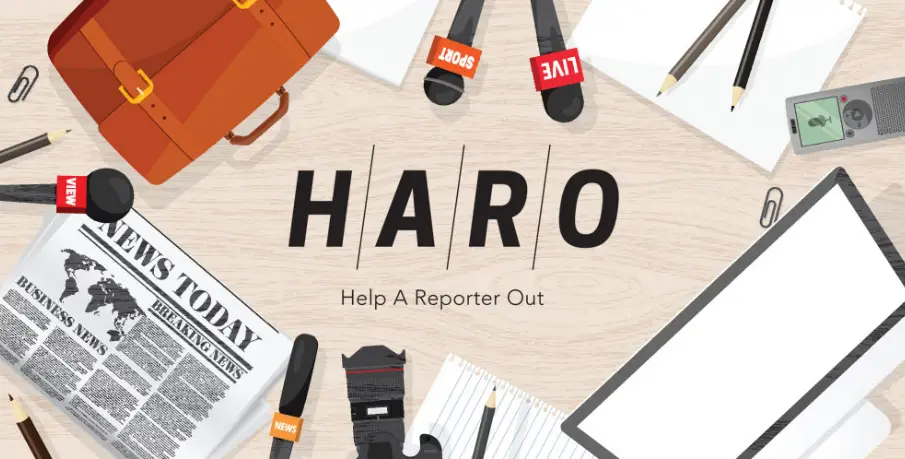I often earn from qualifying purchases. This includes Amazon Associates.
HARO link building has taken the SEO industry by storm for a good reason.
With HARO, you can land high quality links from publications like The New York Times, Wall Street Journal, and Forbes.
And the best of it all?
You can drive organic traffic, leads, and sales if properly used.
HARO can also help you convey your expertise and increase brand awareness. However, with increasing competition, getting results through HARO is not guaranteed.
In this post, we’ll share our top tips and tricks on building links with HARO, so you can beat the competition and build your domain’s authority.
What is HARO?
HARO stands for “Help a Reporter Out” — a platform that connects bloggers, journalists, and businesses with industry experts on upcoming stories.
Ideally, journalists leverage the power of HARO to find reliable sources for their upcoming stories.
As a HARO source, you’ll send email responses to journalists’ questions. You’ll be entitled to a backlink if your answer is shortlisted or accepted.
How Does HARO Work?
HARO allows journalists to post queries or requests for individuals and organizations to respond with relevant information.
Understanding how HARO works can be highly beneficial if you’re interested in getting your brand or expertise in front of journalists to enrich your stories.
How Does Haro Work for Sources?
Sign up for the free Basic plan on HARO’s website. HARO also offers three paid subscription tiers for sources, including keyword alerts. You should get at least three emails on weekdays between 05:35 hrs, 12:35 hrs, and 17:35 hrs (all in Eastern Time).
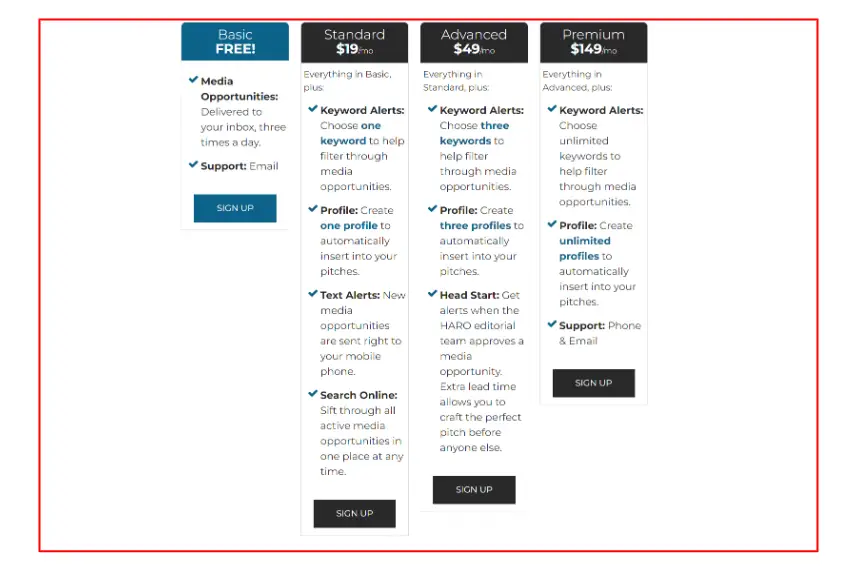

Each email contains a list of journalist queries sorted by category. You can tick the boxes for the categories most relevant to your expertise, so you’ll only receive queries from those categories.
Each HARO query includes the journalist’s name, media outlet, deadline, and a summary of the story they’re working on. You’ll also see any required credentials and what to include with your pitch. Make sure to check all the boxes.
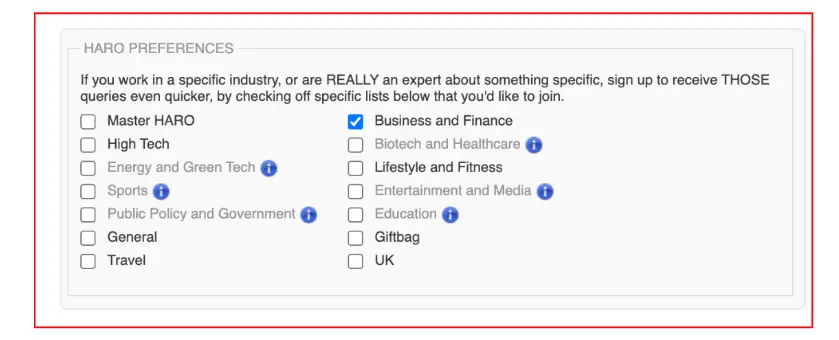

When you find a query relevant to you or your business, write a pitch and submit it to the journalist using the masked email address provided with the query.
How Does Haro Work for Journalists?
HARO is free for journalists and media outlets to use. Here’s how it works for journalists:
- The media outlet must be at least one month old and have a Similarweb rank of at least 1 million to qualify.
- Once the outlet is qualified, journalists can create a query on the HARO website, specifying the type of sources they’re looking for and the submission deadline.
- The query is sent out to all sources who have signed up for HARO’s Basic plan and who have ticked the categories relevant to the query.
- Sources interested in the query will submit a pitch to the journalist using the masked email address provided.
- Journalists can also browse and respond to queries directly through the HARO website.
Is HARO Good for Backlinks?
Regarding search engine optimization (SEO) and public relations (PR), the Haro service can offer some significant benefits.
One of the most notable benefits of acquiring links with Haro is its low-maintenance approach. Rather than spending countless hours prospecting and pitching, HARO queries come directly to you, making it a more passive way to build quality links.
Additionally, you can see results relatively quickly, especially for new websites or blogs. HARO can also help generate social proof, boosting your brand’s credibility and improving website conversions.
Overall, HARO outreach is an excellent way to increase brand awareness, build high quality backlinks and improve your overall SEO performance.
However, remember that providing high quality content, responding to inquiries, and being patient is crucial for HARO success.
How Do I Create a Haro Backlink?
Follow these five simple steps to get started:
- Familiarize yourself with HARO’s rules: Before creating an account, ensure you understand HARO’s rules for sources. Violating these rules could result in being banned from the platform.
- Create an account: Once familiar with HARO’s rules, create an account by clicking on ‘SIGN UP‘ and choosing one of the four plans. The free service provides three Haro emails per day, while the paid plans offer additional features to help you find the most appropriate requests.
- Find appropriate requests: As a HARO member, you’ll receive emails with requests from journalists looking for sources. Make sure to filter out HARO requests that don’t match your area of expertise to save time.
- Create HARO pitches: Once you’ve found a suitable request, create a well-crafted pitch that thoroughly answers the journalist’s questions. Keep your response concise and limited to a few hundred words to ensure it’s easy for the journalist to read and use.
- Help a Reporter Out: After submitting your pitch, await a response. Some journalists may contact you if they use your contribution, while others may not. Only follow up on pitches if you receive a response. Set up a Google Alert for your name to receive notifications if your contribution is published.
Following these steps can increase your chances of getting quality Haro backlinks, boosting your website’s visibility and awareness.
Remember to prioritize pitches within your expertise, respond quickly to requests, and craft a well-thought-out response to achieve success.
How to Use HARO for PR?
HARO can also be a valuable tool for PR professionals looking to increase their visibility and credibility in their industry.
It connects journalists and bloggers with sources who can provide expert opinions or insights on specific topics. To use the HARO link building service for PR, you need to sign up as a source and receive daily HARO email alerts with queries from journalists.
Respond promptly and provide relevant and valuable information to increase your chances of being featured in their article or blog post. Follow their guidelines, provide accurate information, and showcase your expertise to build your brand and gain media coverage.
How to Set up a Haro Account
Setting up a HARO account is quick and easy.
Start by going to the HARO website and clicking on the sign-up button.
Next, fill out the form by entering your details — email address and name, and other information you may be requested.
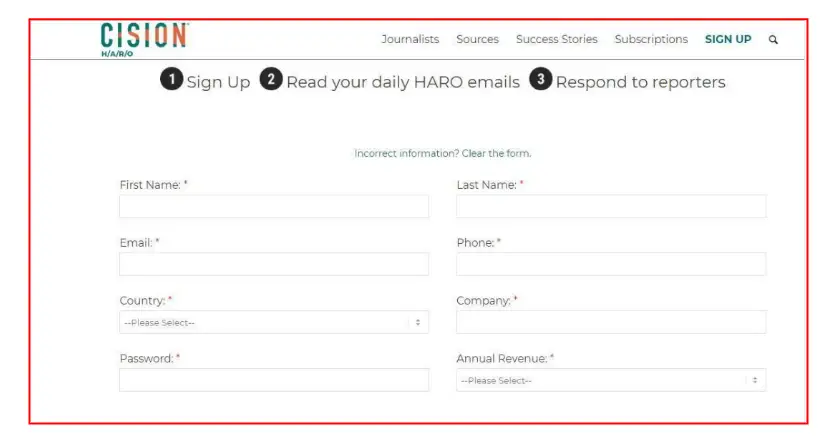

Agree to the terms and prove you aren’t a robot. You’ll be sent a verification email, which you’ll need to click to activate your newly created account.
Select the industries you want to receive queries on to ensure you receive queries most specific to your expertise. You can add contact information or simply hit save and update to complete the process.
Once your account is set up, you’ll start receiving emails daily with queries from reporters. By following these simple steps, you’ll be on your way to using HARO for PR and gaining valuable media exposure.


How to Identify the Best Queries to Pitch
Identifying the best queries to pitch is crucial to your success when using HARO link building.
Below are some tips you can use to identify the best queries to pitch:
1. Focus On Your Area of Expertise
It is essential to focus on queries relevant to your industry and expertise.
While answering as many questions as possible may be tempting, I recommend you play low and answer relevant ones within your industry expertise.
Personal experience gives content a unique point of view, so always speak from your own experience and perspective.
2. Subscribe to the Correct Industry Feed
Ensure you subscribe to the right industry feed that aligns with your business or brand for a better focus on the right queries, ignoring the irrelevant ones.
Choose the right industry when signing up for HARO alerts, and select how frequently you want to receive emails. This will enable you to move quickly and respond to the correct queries.
3. Be Prepared to Move Quickly
HARO opportunities usually disappear as quickly as they come. This usually happens because journalists have assignments with short turnarounds, and HARO sources may respond in large numbers.
When reviewing a query that catches your eye, pay attention to the listing’s deadline, and plan to submit a pitch within 12 hours of receipt.
Crafting the Perfect HARO Pitch
Crafting a perfect HARO pitch is a great way to land valuable media coverage for your business. Here are some tips for preparing a pitch that stands out and gets picked up by journalists.
1. Craft the Perfect Subject Line
Crafting an appropriate subject line is crucial to get replies to your HARO responses. Aim to stand out among the subject lines and establish credibility.
For instance, your subject line could include your HARO response, your job title or expertise, a powerful adjective, and a repeat of the query subject.
Be sure to keep the subject line simple yet catchy, and experiment with different styles to determine which yields the highest conversion.
2. Begin Your Pitch With Background Information
Begin your pitch with a short paragraph that brags about your credentials so that you can stand out. Reporters are looking for authoritative sources, so don’t hesitate to highlight your achievements.
Start with your name, job title, publications, websites and businesses you run, and any relevant credentials to help you stand out. Giving this information is crucial because it helps journalists know who you are and your expertise.
3. Find a Unique Angle
You must add value if you want your reply featured in the journalist’s story. While answering the query requirements is essential, a recycled or mundane response will not stand out.
Try citing personal anecdotes relating to your job title or business, original research you’ve completed, or add controversial points that go against the grain.
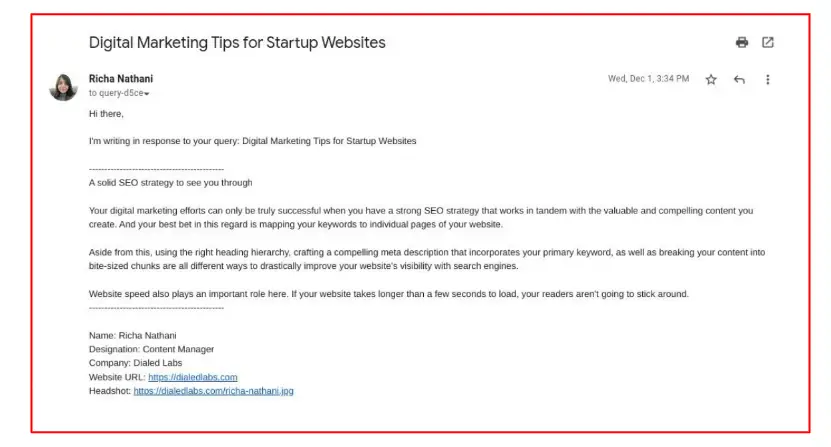

It’s also helpful to research the journalist who submitted the HARO request and add personal notes to your response to show that you put in the extra effort.
4. Read and Understand Pitch Rules Carefully
Be sure to respond directly to the query’s terms and conditions. Trying to game the system or use templates could hurt your chances of getting picked up.
If a publication or name is listed on the request, use them to make your response sound more personal and appealing. Remember to follow the HARO rules.
5. Read all HARO Requirements
Lastly, it’s essential to read and understand all of the HARO requirements before submitting your response. Skipping over these points could ruin your chances of being chosen.
Remember, no quid pro quos (payment for a website URL or link swaps), do not pitch products, link every image, and avoid attachments.
Responding to Haro Queries
Here are ten valuable tips to help you respond to queries:
- Note the requirements: Pay close attention to the reporter’s stated preferences, and ensure you can fulfill them — never answer if you don’t qualify.
- Identify the target audience: Once you have noted the requirements, it’s time to know and understand your target audience — and the information they seek. Your response will be better if you know the target audience.
- Use catchy subject lines: Include information about your qualifications, the story’s focus, and the media outlet in the subject line. Use the terms the reporter will likely look for in their mailbox.
- Prove your authority and credibility: To prove your credibility and authority, including your contact information will help. Strike a balance between completeness and brevity.
- Provide proof: Give responses that show you’ve given it some thought. Be direct, offer a fresh perspective, and support your claims with facts and figures.
- Tell the journalist why your information is important: You should try as much as possible to convince the journalists why your story will add value to their readers.
- Add quotable comments: They’ll love you even more if they can just copy and paste your thoughts into their piece.
- Keep your pitch concise: Your pitch should be between 150 and 300 words long. Use bullet points to make your pitch easy to read and scan.
Tips on How to Use Haro to Build Backlinks and for PR
Here are some tips on effectively using HARO to improve your online presence.
1. Check the Domain Rating
Domain Rating (DR) shows the relative strength of your website’s backlink profile, according to Ahrefs. A higher DR for the media outlet you’re pitching to will help you increase your website’s DR, thus, higher chances of ranking better in the SERPs.
Checking the media outlet’s DR (on Ahrefs) will help determine whether they are worth your time.
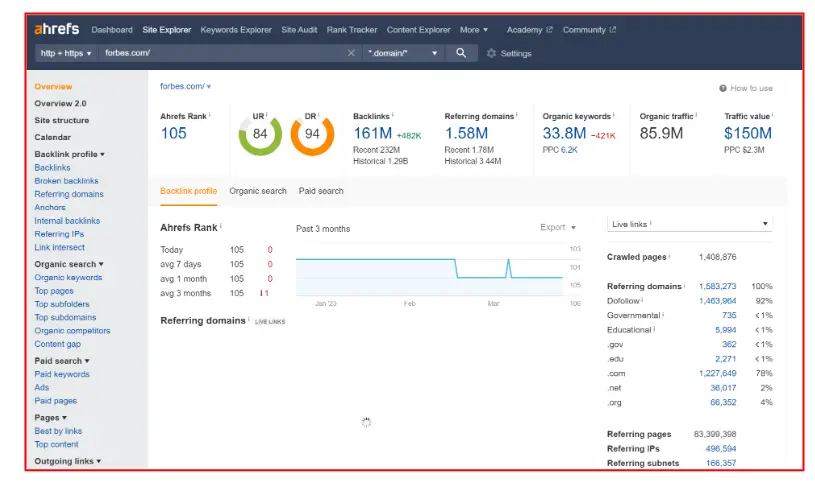

It’s important to note that while DR is critical, it’s not the only factor to consider when pitching to a journalist. You should also consider other factors such as relevance, the journalist’s audience, and the publication’s tone.
2. Find Relevant Queries
Numerous HARO queries are posted daily, so it’s crucial to only respond to those relevant to your niche.
Responding to irrelevant queries can hurt your chances of building relationships with journalists and getting future opportunities to pitch your business.
3. Show Credentials
Make it clear immediately that you are a credible source for journalists by outlining your relevant experience and credentials — to increase your chances of getting HARO backlinks.
Don’t underestimate how powerful your credibility can be.
However, you don’t have to be a celebrity or an industry expert to build links from a major publication. All you need is relevant experience and being ready to offer valuable insights to journalists.
4. Send Your Pitch Within Thirty Minutes
Journalists value time, so you must be proactive with your HARO responses. HARO queries usually have pitch deadlines, so be among the first to respond and improve your chances of getting chosen.
Journalists often look for quick quotes for their press releases — not your life story. Pitch with this in mind and respond within thirty minutes. A fast response will win you HARO links!
However, never sacrifice quality for speed — make sure your response is still relevant, valuable, and well-written.
5. Make Your Response Quotable and Quantifiable
Journalists will give more weight to your comments if you cite specific examples and data to support your claims.
So, use quotable language.
Think about how your answer would look in a Newyork Times article. Is it a comfortable fit, or does it have an awkward tone?
Quotable passages are concise, memorable, and full of insight. Journalists will likely choose your pitches if you provide clear and concise writing.
6. Don’t Follow Up Unless You Get Responses
Time is of the essence, so if you don’t hear back from the journalist, assume that they have rejected or deleted your response.
Do not pursue them any further.
The journalist will see this as an attempt to manipulate them into giving you high-authority links and media coverage, and they will be less likely to work with you in the future.
7. Not Every Pitch Will Succeed
The HARO success rate is typically between 5% and 10%.
While there are experts who can boost this, no one can guarantee every pitch will receive media attention or a high-quality backlink. Therefore, maintain an upbeat and steady attitude when sending out HARO requests.
8. Build Relationships
Using HARO is about more than just gaining high authority backlinks; it’s also about establishing a relationship with the media.
Send the article to your contacts, and then follow up with the journalists to express your gratitude and provide assistance with future articles.
9. Monitor your Success
Use spreadsheets to track how you’ve progressed. This way, you can measure, scale, and optimize your Haro link building efforts.
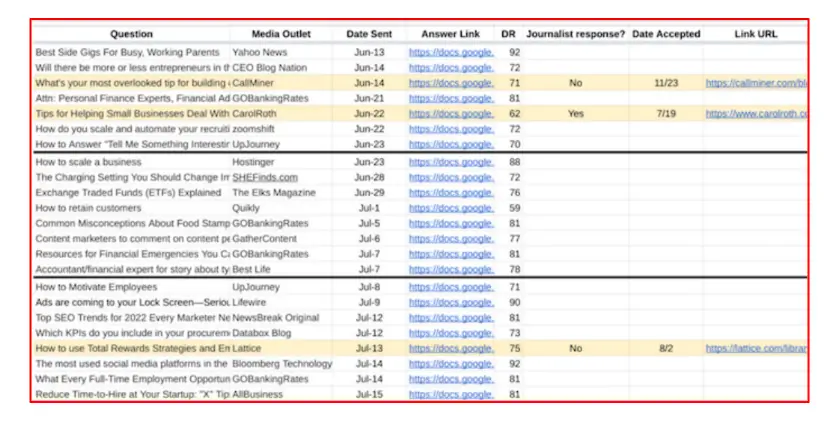

10. Use Google Alerts
Create a Google Alert to be notified whenever you receive new links. Do site searches and use SEO tools to monitor for new dofollow backlinks and nofollow links regularly. This can be useful for spotting regularities and tendencies in the HARO links you’re receiving.
11. Use HARO as Part of Your Backlink Strategy
In addition to HARO, there are many other ways to get more links, such as niche content, guest posting, infographics, statistic posts, lead magnets, and content syndication. Use Haro for link building as part of your overall backlinking strategy — not just the only one.
Common Haro Mistakes to Avoid
Help a Reporter Out is an excellent way to connect with journalists, but there are several mistakes you should avoid to maximize its benefits. Here are five common mistakes you should avoid while using HARO:
1. Not Checking Your Email Frequently Enough
HARO is an opportunity to connect with journalists and build relationships, but you must be responsive to use it to your advantage. Journalists may contact you at any time. You must therefore check your email frequently to respond promptly.
2. Not Responding Quickly Enough
In addition to checking your email regularly, you must respond quickly to queries. And because journalists work with time, it’s always best to respond to them within a specified period — a delay could make them pursue other options.
3. Sending the Same Pitch (or Templates) Over and Over Again
Sending the same pitch repeatedly to journalists is an ineffective way to get their attention. Be patient and send them different pitches until one stick.
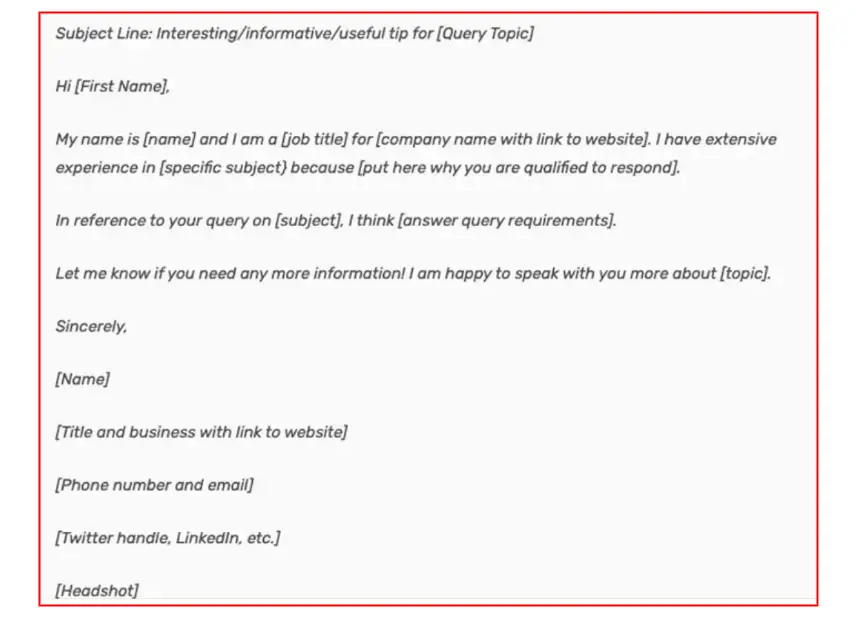

4. Not Following Up
Follow your pitches if you don’t hear from a journalist after a few days. Please remember that journalists receive several emails daily, and yours could have ended in spam or been deleted by mistake.
5. Writing Too Long of a Response
Journalists work on tight deadlines and receive hundreds or thousands of responses to their queries. Respond with 3-7 sentences or one paragraph to make it easy for them to skim your response and determine if it’s relevant to their story.
Wrapping Up
As we conclude, HARO is a powerful tool for building high-quality backlinks. Building links through HARO is an excellent SEO strategy as they enhance your website’s authority, thus increasing traffic.
However, it’s important to remember that journalists are highly skilled in identifying poor-quality sites and experts, so you must showcase your expertise and authority to stand out.
Using HARO and some of the best link building strategies from SEO agencies, you can promote your brand and elevate your business to the next level.
HARO FAQs
Does HARO Cost Money?
HARO offers a free version and other HARO link building pricing packages. However, I recommend you go with any of their paid plans for better perks!
How Do You Get Featured in HARO?
To become a source on HARO, register and monitor source requests three times a day. Then, send the perfect pitch to the masked email address listed in the source request.
How Do You Get Quoted in the Media?
First, establish relationships with journalists. Instead of pitching publications, pitch specific journalists or freelance reporters who cover topics related to your expertise.
Look for journalists who have already written about your field or a similar topic, and personalize your pitch to them. Finally, leverage social media platforms like Twitter to connect with journalists and promote your expertise.
Amazon and the Amazon logo are trademarks of Amazon.com, Inc, or its affiliates.

